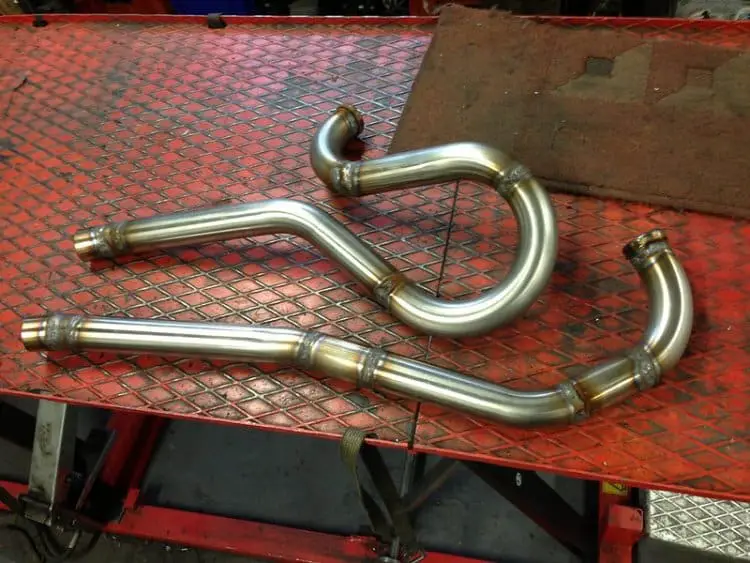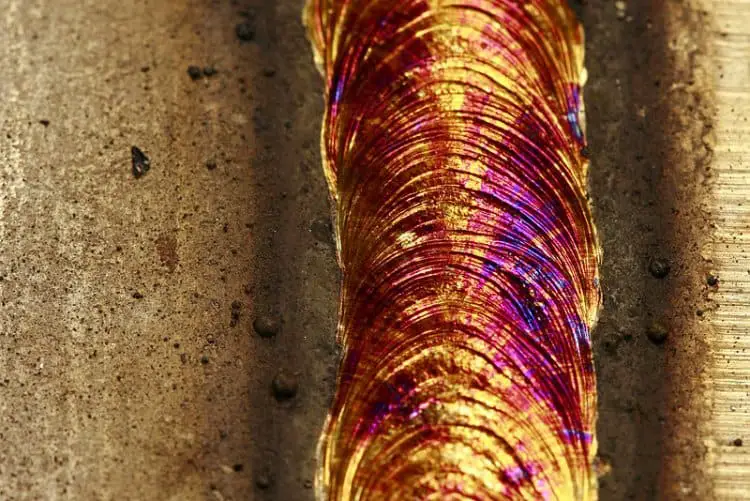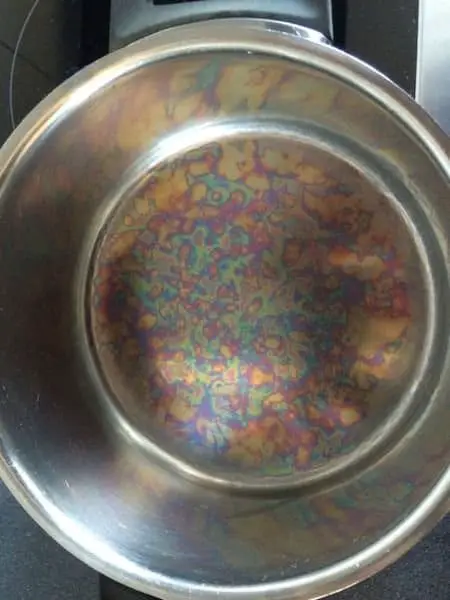This post contains affiliate links to products, services, or education. We may receive a commission for purchases made through links.
Stainless steel is an attractive material that can make for beautiful welded projects. Unlike most kinds of steel, stainless won’t rust or corrode when exposed to the elements. However, stainless steel can discolor after welding and lose both its good looks and its corrosion resistance. To keep your stainless-steel project looking good for years to come, you need to do some finishing after you weld.
What is the best way to restore the appearance of stainless steel after welding? You must remove the discolored layer to finish the steel. There are several ways to remove this layer, including chemical baths, pickling pastes, electrochemical finishing, and manual grinding. Each has advantages and disadvantages.

You might also want to perform some more grinding and polishing to reduce the weld bead and to match the finish of the welded area to the rest of the surface.
In some applications, one or both steps may be necessary. In others, you don’t have to do either one.
Why Does Stainless Steel Discolor?

Stainless steel is an alloy of iron, carbon, and chromium. The chromium in the steel reacts with oxygen to form a thin layer of chromium oxide on the surface of the steel.
This process is called “passivation.”
This process seals the surface of the steel and protects it from further rusting so that it stays bright and shiny. The passivated layer is self-healing, too.
When it gets scratched, the freshly exposed metal will react with the air to seal the scratch.
Welding corrodes this chromium oxide layer and discolors the steel. This discoloration is called “heat tint.”
The heat tint layer doesn’t have as much chromium as the rest of the steel, so it won’t form a passivated layer.
The absence of this layer means you have ordinary steel exposed to air and moisture. This layer will rust just like high-carbon steel.
To retain the highest level of corrosion resistance, you must remove the heat tint layer and get back down to bright silvery steel. If you leave the heat tint alone, it will corrode faster than the rest of the metal. It won’t take long for your weld joint to look like a mess on an otherwise bright surface.
Start with the Bead and Work Out
Before addressing the heat tint, you may want to grind down the weld bead. It’s best to do this first because you want the process of cleaning the heat tint to clean the top layer that will remain. I
f you clean the heat tint and then grind the bead, you’ll have to handle the heat tint again in the freshly exposed joint.
Not every project will require grinding the bead. If yours doesn’t, feel free to skip this step.
To remove the bead, grab an angle grinder, and get to work. Depending on the project, you may want to smooth out the bead or remove it entirely.
Here is a list of reasons you might want to remove the weld bead:
- You are working with food or pharmaceutical equipment, and the surface must be smooth for cleaning and safety
- The project will be highly visible and should have a consistent, smooth surface such as a railing or countertop
- You don’t like the way the bead looks and want it gone
Grind Down The Bead

Start by grinding the bead with an angle grinder using a flap wheel with 40, 60, or 80 grit. This will remove the bead without removing too much of the metal underneath it.
Using an aggressive grit will remove the bead faster than a fine grit, but you will have to polish out the grind marks to match the rest of the project.
For hard to reach spots, check out a specialty grinder such as a fillet weld grinder, a horizontal-shaft grinder, or a die grinder. These grinders let you get into inside corners, concave spaces, and other odd spots.
This is important for foodservice applications, but you can skip it if you are only concerned about appearance and not sanitation.
If you aren’t going to do a lot of inside corner grinding, you can use a flexible shaft on a rotary tool with the appropriate grinder wheel to get into nooks and crannies. It won’t break the bank like a specialty grinder, and you’ll find lots of other uses for the rotary tool.
It’s slower than a special grinder, but that’s fine for occasional projects.
Whatever you use, work slowly along the weld bead until it has been ground flush with the metal on either side.
For cosmetic purposes, it’s most important to get it flush on the top side where the joint can be seen and felt. It’s less critical to grind the bead down in internal corners.
Keep grinding until you have a smooth surface, then start in on the heat tint.
Removing Heat Tint From Stainless Steel
Once the bead is in its final state, you can start working on the heat tint.

For projects involving stainless steel, this stage isn’t optional. If you don’t remove the tint, the project will rust. There is no reason to go to the expense of using stainless steel if you are going to let that happen.
You could just use cheap rolled steel instead.
Methods to Remove Heat Tint From Stainless Steel
There are several methods to remove heat tint. Each one has advantages and disadvantages.
Acid Baths to Remove Stainless Steel Welding Heat Ting
Soaking the weld joint in a bath of nitric or hydrofluoric acid will remove the heat tint with ease.
Shops that do lots of stainless work have large tubs of acid for soaking off heat tint.
Make sure you wear adequate protective equipment and neutralize the acid after the piece comes out of the acid.
Advantages of acid baths:
- Once the bath is set up, it is relatively inexpensive, compared to other methods
- Acid baths are great in high-volume environments for folks who weld a lot of stainless steel
- Requires very little labor
Disadvantages of acid baths:
- The setup costs can be high, especially if you are just working on a few pieces
- You are working with some really, truly nasty acids and need to take safety precautions
- The acid must be neutralized after soaking the welded piece
- If you forget to remove the part, it may be gone when you get back
- Won’t work for big pieces that can’t fit in the bath
Acid Baths are Best for:
Acid baths are best for high-volume environments, small parts, and low-profit margins.
They don’t require much labor. Acid baths are a good solution for shops that crank out lots of stainless steel regularly and don’t spend a lot on cleaning.
If you choose to use acid baths, you need to provide a dedicated setup and follow safety precautions.
Electrochemical Cleaners for Removing Heat Ting After Welding Stainless Steel
This process uses a combination of low-voltage electricity and weak acid to remove heat tint. It is the opposite of electroplating metals.
Electroplating uses electricity to add a layer of bright metal on top of cheap base metal. Instead of using an electric current to add a layer to the base metal, electrochemical cleaning uses the current to pull a layer off the base metal.
This removes the heat tinted layer and gets you back to 100% stainless.
Advantage of electrochemical cleaners:
- The cleaning process uses phosphoric acid, which is much safer than acid baths or pickling paste. How much safer? Another use of phosphoric acid is to give the tangy, sharp flavor to cola drinks.
- These cleaners won’t over- or under-clean the surface.
- The resulting surface has a bright, beautiful finish – if you need a mirror finish, electrochemical cleaning is a good start
Disadvantages of electrochemical cleaning:
- Electrochemical cleaning machines are expensive – new TIG welder expensive
- Doesn’t work well for high-volume environments
- May not work for large parts that can’t go in a bath
electrochemical cleaning Is Best for:
Electrochemical cleaners are suitable for small shops that do stainless regularly but in low volume. They produce a bright shine, better than any other method of removing heat tint.
They are also useful for home welders who weld lots of stainless and are willing to invest in the equipment.
They are expensive but safe and effective. These cleaners are great for sculptors or making custom auto accessories.
Physical Grinding Stainless Steel
Another way to remove heat tint is to grab your angle grinder or belt sander and get to work. The grinder physically removes the top layer of metal that is heat tinted. Just keep grinding until the heat tint is no more.
Advantages of physical grinding:
- You already have the equipment. (if you don’t, get an angle grinder. Every welding shop should have at least one.)
- Works for large parts or built-in equipment
- Least likely process to be overdone
- If you grind the bead off, you have already made a good start on this
Disadvantages of physical grinding:
- It’s the slowest process
- May not result in a good passive finish to seal out corrosion
- Not suitable for high-volume production
- Hard to use with very small or intricate parts
Physical grinding is Best for:
Physical grinding is useful for occasional stainless projects, tight budgets, and pieces that won’t be exposed to the elements much, like indoor railings and counters. It’s also useful for projects that will be polished to a high shine because you need to do lots of grinding anyway.
Can I Remove Welding Heat Marks With Blast Cleaning?
Using a sandblaster or other abrasive spray cleaner will remove heat tint as effectively as physical grinding. Sand, glass beads, and walnut shells can all be effective.
Advantages of blast cleaning:
- Faster than grinding
- Safer than chemical methods
- Easier to get into tight corners than grinding
- Many shops already have the equipment, especially auto body shops
Disadvantages of blast cleaning:
- Equipment is expensive if you don’t already have it
- Like grinding, doesn’t always produce the passive finish that repels corrosion
Blast Cleaning is Best for:
Blast cleaning of heat tint is best for shops that already have the equipment to blast-clean metal.
If you’re set up for sandblasting auto bodies or other painted work, blast away.
If you don’t have much use for a sandblasting setup but want to spend money on stainless steel finishing, you should probably look at electrochemical equipment instead.
Is Pickling Paste A Good Way To Remove Weld Heat Marks From Stainless Steel?
Pickling paste is a material made from hydrofluoric and nitric acids, along with thickening agents.
Pickling paste has a thick, gel-like texture.
It is brushed or sprayed on the heat tint, left to work for a time, then rinsed away. It uses the same chemistry as an acid bath, but you apply the paste to a static part instead of dunking the piece.
Advantages of pickling paste:
- Least expensive option for removing heat tint. Doesn’t require any special equipment except for personal protective gear.
- Great for occasional use.
- Works on parts that can’t be dropped in a bath to soak or be cleaned electrochemically.
- Requires less labor than grinding.
Disadvantages of pickling paste:
- Acids involved are highly corrosive and will cause burns
- Thick consistency means it will stick and burn whatever it touches, including you
- Produces nasty fumes that must be vented
- Runoff from pickling paste is nasty and needs to go somewhere
Pickling Paste Is Best for:
Pickling paste is best for occasional use, large or built-in projects, small shops that don’t want to invest in expensive setups for cleaning stainless steel. If you weld stainless once every six months or so, pickling paste is the best way to go.
What Is The Best Method To Finish Welding Heat Marks On Stainless Steel for Beginners or Weekend Warriors?
If you aren’t dedicated to fabricating stuff from stainless, grinding and pickling paste are good options.
Both are inexpensive and easy.
Each has advantages and disadvantages. Grinding is easy since you already have a grinder, but it takes a long time.
Pickling paste is the other good choice for weekend welders. It is simple, inexpensive, and doesn’t take lots of work. It is dangerous, but no more so than welding or using a cutting torch. You should be aware of the necessary safety precautions if you are going to use it, though.
Pickling Paste Safety
Before you apply pickling paste, be aware of the necessary safety precautions. You will need to wear eye protection and have gloves that will protect against the paste. A clear face mask is also recommended.
Nitrile gloves offer the best chemical protection but check the directions and wear what the pickling paste manufacturer recommends.
In addition to face and hand protection, think about wearing a chemical-resistant suit of rubber or similar material and rubber boots.
This is especially important if you are going to be spraying the paste on or washing it off. The water rinsing the paste away can splash and cause acid burns.
Pickling paste also produces fumes.
To avoid inhaling them, make sure the area is well ventilated. Let the metal cool after welding – hot steel can cause faster reactions with the paste that release toxic fumes.
You don’t need a respirator unless there is no way to vent the work area. Use the application brush that comes with the paste or purchase an acid-resistant brush to apply it.
When removing the paste, be as gentle as possible. A wet cloth or sponge is the best way to remove the paste, followed by a gentle spray of water.
Avoid using pressure washers if you can – those will splash the paste all over the place. Be careful with the runoff from washing off pickling paste – it is highly acidic and may be considered a pollutant in your area.
Final Finishing Stainless Steel Welding Heat Marks
For projects that aren’t highly cosmetic, removing the heat tint is the end of the road. For projects that need a high luster or a specific appearance, it’s time to grind and polish.
There are several different levels of finish that require different abrasives and techniques.
These finishes are a sequence.
That is, you must go through a coarse finish to get to any other.
To get a true mirror finish, you will need to go through each of these steps. Make sure to use an abrasive for stainless steel to get the best results and minimize contamination that can cause rust.
If you use the same grinder wheels for stainless steel that you use for regular steels, you risk contaminating the stainless.
The grinder can pick up particles of ordinary steel, then smear the regular steel into the stainless.
The result is a layer of plain steel that will rust on top of your stainless steel. You are better off not grinding the stainless than using a contaminated grinder.
Coarse Finishing Stainless Steel
This finish leaves everything looking consistently dull. It’s about what you get after grinding down the bead, but before removing the heat tint.
This finish is best applied with a 40-grit ceramic flap wheel.
Just go over the whole surface until everything looks the same. This is usually an industrial finish in applications that don’t need to be sterilized.
Brush Finishing Stainless Steel
The brushed finish has little shine and doesn’t show fingerprints or other smudges very well. It’s attractive but not flashy.
To get a brushed finish, use a flap wheel or a fiber-backed wheel of 80 or 120 grit. This is the preferred finish for commercial kitchen equipment. It won’t encourage bacterial growth, but it won’t look filthy after heavy use, either.
Brushed finishes are also popular in architectural applications. It looks good and resists corrosion, but it won’t show fingerprints or smudges.
This finish looks clean with minimal upkeep.
Belt sanders are good for getting a brushed finish because it’s easy to keep the belt running in the same direction. Make sure you keep the sanding parallel so that the final finish shows a consistent grain pattern.
Satin or Matte Finishing Stainless Steel
The satin finish requires more work to get an even, bright tone that isn’t too reflective.
Follow up the treatment for a brushed finish with more grinding using a wheel or sander with 220 or 240 grit abrasive.
To create a matte finish without any grain to the metal, use a 320-grit grinder and work out all of the tool marks from the previous grinding.
The most significant difference in a brushed finish and a satin or matte finish is the direction of the brush marks.
Satin and matte finishes don’t have any direction to the marks. To remove the directional brush marks, use a random orbit sander or vary the course of the belt sander until no grain shows.
Reflective Finish
A reflective finish is bright and shiny, but not actually a mirror. This finish requires you to go from a grinder wheel to a polishing wheel with a separate abrasive powder.
Use a cloth fiber wheel loaded with an abrasive polish to bring the steel up to a bright shine.
To get a bright reflective finish, you will have to work up from 320 grit through finer grades until you are up to about 1500 grit.
As with satin and matte finishes, use a random orbit sander or vary the direction you sand, so the scratches are minimized.
If you want to produce a lot of stuff with a reflective or mirror finish, check out electropolishing equipment.
Start-to-finish time with electropolishing isn’t faster than hand grinding and polishing; however, the labor requirements are much lower. You connect the electropolishing equipment, drop the steel in the tank, and walk away.
That’s easier than running a grinder all day.
Mirror Finishing Stainless Steel
The top end of stainless-steel finishes is the bright mirror finish. It’s so shiny that you can see yourself in it (hence the name).
This requires lots of polishing, then buffing with a buffing compound. It takes a while to reach this finish, so keep at it.
You’ll have to work and work to bring stainless up to this level.
An authentic mirror finish requires lots of polishing after you get to the reflective finish stage. You need a polishing or buffing compound and a polishing wheel to get a full mirror finish.
You should also bring a lunch – this finish takes a long time to achieve with a grinder. You might want to apply a clear coat or sealant to a mirror finish to keep it at its best.
Bead-Blasted Stainless Steel Finish
One unique finish you can apply if you have sandblasting equipment is a bead-blasted finish. Using glass beads to work on the surface of the metal lets you get a uniformly smooth surface with no polishing grain, but still appearing very dull.
This finish can be a nice contrast to highly polished finishes. This is also an easy-care finish like a brushed finish.
Stainless Steel Electropolished Finish
Another way to get a very high level of shine, similar to a mirror finish, is to use electropolishing equipment. This is a process similar to electrochemical cleaning but configured slightly differently.
This process focuses on producing a consistent, smooth surface across all the stainless steel instead of removing heat tint.
Stainless Steel Finishing Standards
Industrial stainless-steel fabricators actually have a standard set of finishes that they can specify when manufacturing equipment. Here are the grades of stainless-steel finish, from dullest to brightest.
| Number | Process | Appearance |
| No. 0 | Hot rolled, then annealed | Dull, rough |
| No. 1 | Hot rolled, annealed, then passivated | Dull, rough; resists corrosion |
| No. 2D | Cold-rolled, annealed, pickled, passivated | Smooth, dull, resists corrosion |
| No. 2B | Cold-rolled, annealed, pickled, passivated, rolled through polished rollers | Smooth, dull, corrosion-resistant. This is the most common finish for raw stainless steel |
| No. 2BA | Same as 2B, plus annealed in an oxygen-free environment | Brighter than 2B |
| No. 3 | Coarse ground with 120 grit | Brushed, coarse grain |
| No. 4 | Ground with 150 grit | Bright with visible fine grain |
| No. 5 | Ground with 220 grit | Satin finish; no grain |
| No. 6 | Ground with 320 grit | Matte finish; brushed but has a finer grain than #4 |
| No. 7 | Grind marks removed; surface polished | Reflective finish |
| No. 8 | All grit lines buffed out with polishing compound; all defects polished out | Mirror finished |
| No. 9 | Bead blast | Dull, no grain |
| No. 10 | Heat colored or electropolished | Wide range of finish colors |
When stainless steel is commercially finished, these grades are specified in the product requirements. No. 4 finish is the most common finish for architectural work.
No. 5 and No. 6 are used for food manufacturing and restaurant equipment. No. 5 is the minimum needed for food equipment, while No. 6 is used in restaurants and kitchens where appearance is essential.
No. 7 and No. 8 are similar finishes. The difference is in reflection quality. No. 7 is bright and shiny, but not really a mirror. No. 8 is the finish you’d want in a mirror for shaving or applying makeup – it’s perfect.
Wrapping Up
Stainless steel has a reputation for being difficult to work with. That is because it’s hard, resistant to corrosion, and it requires lots more post-weld work to look its best.
The hardness and corrosion resistance also put stainless steel in high demand for decorative welding projects.
Figuring out how to weld, clean, and finish stainless steel can seem intimidating at first, but don’t get discouraged.
It is just a metal, and a good welder can figure out how to weld, clean, and polish it. Plan a project, buy some stainless, and get to work – you’ll be surprised how easy it is to create stunning projects.

